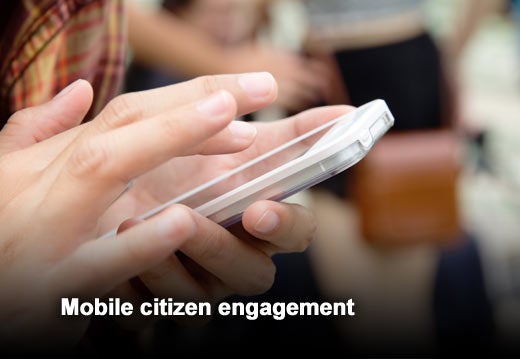The nexus of forces, which is the convergence of four powerful forces: social, mobile, cloud and information, is driving innovation in the government sector, according to Gartner, Inc.
“Smart government integrates information, communication and operational technologies to planning, management and operations across multiple domains, process areas and jurisdictions to generate sustainable public value,” said Andrea Di Maio, managing vice president at Gartner. Gartner has identified the top 10 technology trends that government IT organizations should factor into their strategic planning processes.
Click through for the top 10 technology trends that government IT organizations should factor into their strategic planning processes, as identified by Gartner, Inc.
Personal mobile workplace
Regardless of how well government IT organizations try to categorize the types of devices, applications and interaction styles by user role, they will inevitably miss the fact that on any device, personal use will creep into professional use. Government IT organizations may have an illusion of control by either providing and managing those devices or issuing well-articulated policies to allow and manage employee-owned devices. However, the reality is that employees, depending on demographics, personal preferences and pressure to improve performance, can decide how much they want to use corporate information and applications versus personal information and applications.
Mobile citizen engagement
Several inquiries with Gartner government clients reveal an interest in providing citizen-facing services using mobile devices, as well as leveraging social software functionalities. This interest is driven by a combination of pressure coming from the political leadership and from opportunities that new technologies present. The suitability of government services to be delivered over a mobile channel depends on a combination of demographics, frequency and recurrence of use, immediacy and urgency of use, potential level of automation, relevance of location information for service delivery, and how compelling the use of the service is.
Big Data and actionable analytics
Big Data continues to present government with information management and processing issues that exceed the capability of traditional IT to support the use of information assets. Existing practices that selectively evaluate which data should be integrated are being challenged by the realization that all data can be integrated with technologies that are specifically developed to do so. The adoption of Big Data concepts and initiatives in the public sector varies widely among jurisdictions and, to date, is limited to specific use cases such as fraud, waste and abuse detection; enhanced security capabilities; public health surveillance; health care management; or combining data from IT and operational technology (OT) applications to enhance security monitoring or increase situational awareness. Governments are searching for ways to use Big Data to gain business process efficiencies and reduce costs, but are having limited success.
Cost-effective open data
Many tend to equate open data with public data, however, data can be defined as open when it is machine-readable and is accessible through an API. This can apply to potentially any data that needs to be processed, whether it is public, discoverable through Freedom of Information Act requests, or restricted for use by a particular government agency. This leads to new ways of mashing up data coming from different sources, as well as the ability to build new services and processes based on open data. Governments become both providers of open data to each other and to the public at large (the latter just for public data) and consumers of open data coming from other parts of government as well as from businesses, NGOs and citizen communities.
Citizen managed data
Citizen data vaults are services that provide data subjects with the ability to access their data outside the context of a particular government transaction, allowing them much-finer-grained control over when and how data can be accessed, and by whom, within the relevant legal framework that they are subject to. Citizen data vaults offer significant potential benefits in meeting Internet users’ evolving expectations, providing more transparent control of individual privacy rights on electronic data, easing the task of integrating different government services, and creating conditions for the creation of value-added services from commercial, nonprofit and peer-to-peer organizations (such as social networks). On the other hand, there are significant challenges to overcome, such as interoperability, latency issues, data availability and reliability, credibility and security issues, and the size and complexity of health care and other target areas.
Hybrid IT and cloud
Governments worldwide continue to pursue both public and private types of cloud services, but the focus is shifting from developing internal cloud services to allowing agencies to purchase commercially provided but governmentally restricted services. For example, government clouds from vendors such as Google and Microsoft have shifted email service in a number of agencies from public to government clouds. Meanwhile, more-open public clouds are being emphasized in several countries mostly for non-critical CRM-like applications. The main objectives pushing cloud adoption have been cost reduction, speed of procurement and deployment, and responsiveness to regulations and needs for cost cutting. The public cloud is also gaining momentum as governments seek savings via consolidated procurement.
Internet of Things
The Internet is expanding beyond PCs and mobile devices into enterprise assets such as field equipment, and consumer items such as cars and televisions. Governments, as well as most enterprises and technology vendors, have yet to explore the possibilities of an expanded Internet and are not operationally or organizationally ready. Smart city plans in several jurisdictions aim at exploring the ability to process huge masses of data coming from devices such as video cameras, parking sensors, air quality monitors and so forth to help local governments achieve goals in terms of increased public safety, improved environment, better quality of life.
Cross-domain interoperability
Smart government initiatives depend on interoperable information, data obtained from external as well as internal sources, and processing and delivery networks that effectively integrate planning, performance analysis and business operations. To obtain economies of scale, governments have long sought to standardize and consolidate assets and processes. To date, the results have been mixed. Whole-of-government enterprise architecture programs have often failed to maintain momentum over budget cycles or changes in administration. It is important to focus on scalable interoperability, a “just enough” approach to standards and architecture that delivers immediate business value as measured by narrowly defined, high-priority use cases.
BPM for case management
There isn’t one market for case management because all cases are not the same. Gartner distinguishes two types of cases. In decision-centric cases, the purpose of the work effort is to make a decision about rights, entitlements, payments, enrollment, priorities, risk or some other high-impact outcome. In investigative cases, the outcome is uncertain; the purpose of the work effort is to identify interaction patterns among data. When the case is created, it often has very little data and structure. As the investigation progresses, data is added and patterns begin to appear. Fraud detection and criminal investigations are leading examples of this type. Both decision-centric and investigative cases have a heavy dependence on semi-structured and unstructured information. Two dimensions — workflow and data type — have brought BPMS and ECM vendors into this emerging market.
Gamification for engagement
Gamification can be used by government to motivate interactions with citizens or to achieve more meaningful levels of engagement with employees. Humans are “hard-wired” to enjoy games and have a natural tendency to engage when interactions are framed in a game construct. Gamification for government services, applications and processes can increase user interactivity and change behavior, resulting in greater engagement. Citizens or employees who can have fun are more likely to change behavior, for example, NASA Moonbase Alpha simulates lunar exploration to stimulate teamwork by using a variety of tools, including a lunar rover. However, governments planning to leverage gamification must clearly understand the target audience they intend to engage, what behaviors they want to change, what motivates the audience and maintains their engagement, and how success will be measured.













